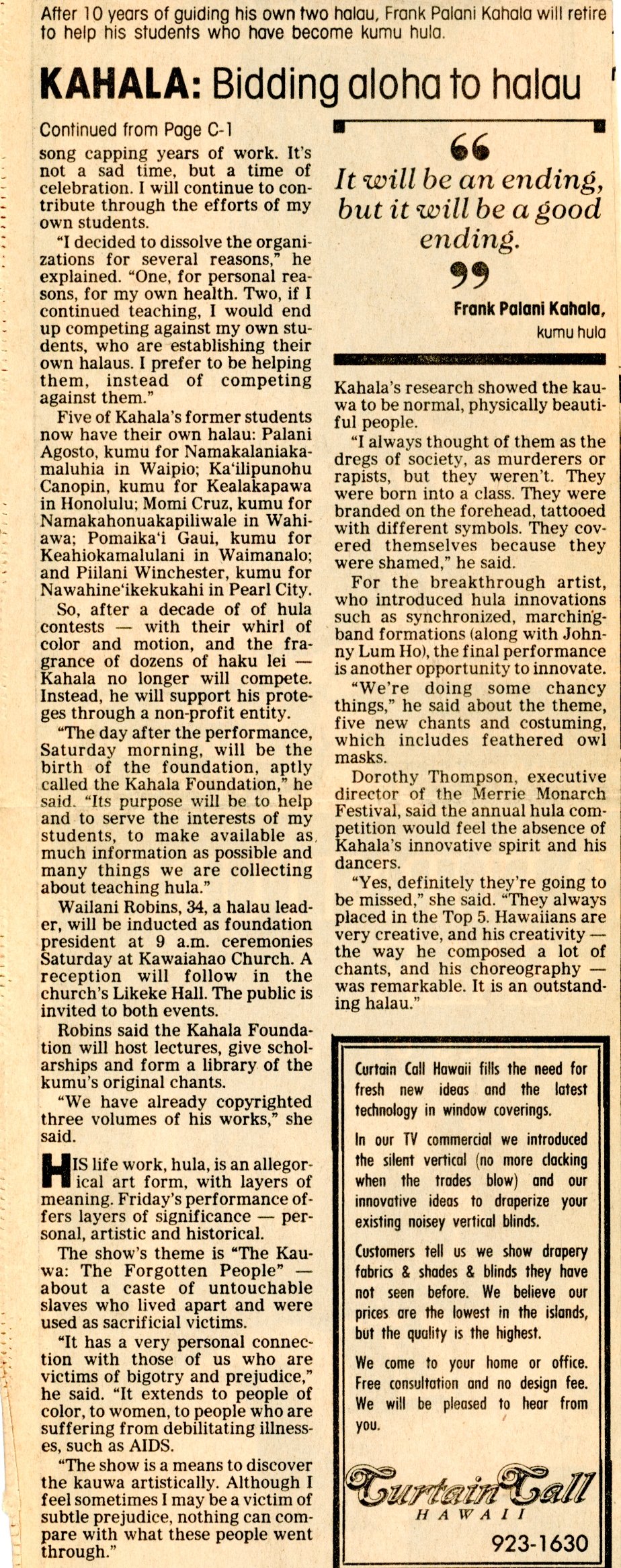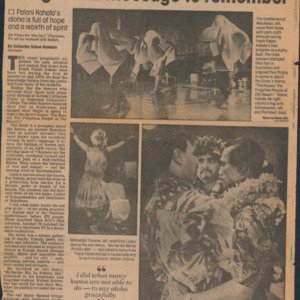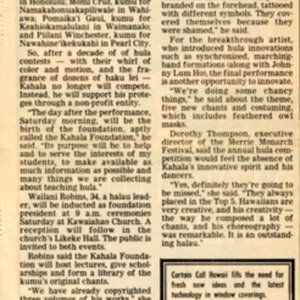Palani Kahala
Title
Palani Kahala
Subject
Nā Kumu Hula PaIani Kahala - Nānā I Nā Loea Hula Volume 2 Page 44
Description
The late Palani Kahala established the Kahala Foundation to perpetuate his original chants and dances. In January 1991 Palani Kahala presented his final performance as kumu hula of the Ladies of Kahanākealoha and the Gentlemen of Maluikeao.
There are two styles of hula kahiko. There’s what I term as classical or traditional hula kahiko and then there is a contemporary styling of ancient hula. Traditional hula has been passed down by succeeding generations. For myself and other hula teachers, we should never change chants like "Kaulīlua," “‘Au‘aʻla,” “A Ko‘olau Au.” We should never try to attempt to re-do something as historically valuable as these dances. If it is the way it was performed, say, a hundred years ago, then it should be the same a hundred years from now. Yet in the same light, this generation of Hawaiians are a source of tradition. Like our ancestors, we share the same spirit of creativity. Things we create today will become the traditions of tomorrow.
Composing mele are a means by which I can express the whole spectrum of human emotion. Some of my greatest moments of composing have come in times of personal strife. Times when I’m going through an emotional or physical crisis often lead to creative moments that swell inside. I find myself being very creative and wanting to write.
I started hula at age seventeen while a student at Kamehameha Schools. My teachers were Robert Cazimero and Wayne Keahi Chang. They came to instruct the school’s Concert Clee Club. Someone came up with the novel idea to turn the training into a formal hālau so members of the group became part of the first men of Hālau Nā Kamalei. I stayed for three years learning hula.
I’ve never ʻūniki in the formal sense, yet I’ve maintained an extensive background in Hawaiian culture having taken classes in Hawaiian language to speak proficiently. Included in my training are culture classes in high school and college. What has helped tremendously is the fact that I hail from Kahana, Oʻahu where remnants of Hawaiian culture still exist.
In 1980 when I returned from serving as an Intelligence Analyst with the 307th Army Security Agency in Ludwigsburg, Germany, I had no plans to teach hula. I was actually planning to attend college to pursue a career in communications hut things changed. My aunt Verna Wilson encouraged me to teach a group of women and that was the beginning of my hālau.
My students are my greatest accomplishments as a kumu hula. When I graduate my students, I expect them to do two things. First, they must develop a sense of discipline. Secondly, ha‘aha‘a or humility and compassion for others. If anything, these are the things that I try to instill in my teachings.
As far as the term itself, kumu means teacher/source and of course, with hula it means hula source. There are those who might argue that a true kumu hula comes from a lineage of kumu hula. I say that is correct but there are some very important teachers in the hula world who don’t possess this particular hula genealogy. Their contributions far exceed many who have had that formal link with the past. In many ways these people should he respected and recognized for their works. They’ve earned the right to he called kumu by the amount of work and dedication they’ve put into it.
I feel competition brings hula into the forefront of public attention. Performing in competitions has built my reputation. I’d be just another unknown had it not been for the exposure of the Merrie Monarch Festival and other competitions.
I felt in the beginning, and I guess its my own immaturity, that winning was everything. At this point in my life, winning is not as important as enjoying what you do. There is a feeling of overwhelming joy to perform. That feeling is more important than the opinions of the competition judges. No one can take that joy away. No one can take away that feeling that you are a winner just for trying. A trophy is merely a symbol recognizing excellence and achievement but that doesn’t mean you didn’t do well.
I think I have a definite style of hula. Nothing specific yet there are certain hula moves that can be attributed to me; certain concepts and ideas which I have helped to promote; things people would come back and say, “Hey, that’s very Palani Kahala.
I don’t believe in originality. I merely think that what is labeled as original is a recombination of ideas that have been tested before. A good kumu hula takes the very best of what he’s learned and looks at it from another perspective. If that is originality, well, I’m guilty. I do it all the time. In developing style I watch, look, and listen — not only to hula but all forms of dance such as ballet, jazz, other ethnic dances, and I can see the ideas that they’ve generated.
"When I graduate my students, I expect them to do two things. First, they must develop a sense of discipline. Secondly, ha ‘ahaʻa or humility and compassion for others. ”
44 Palani Kahala
There are two styles of hula kahiko. There’s what I term as classical or traditional hula kahiko and then there is a contemporary styling of ancient hula. Traditional hula has been passed down by succeeding generations. For myself and other hula teachers, we should never change chants like "Kaulīlua," “‘Au‘aʻla,” “A Ko‘olau Au.” We should never try to attempt to re-do something as historically valuable as these dances. If it is the way it was performed, say, a hundred years ago, then it should be the same a hundred years from now. Yet in the same light, this generation of Hawaiians are a source of tradition. Like our ancestors, we share the same spirit of creativity. Things we create today will become the traditions of tomorrow.
Composing mele are a means by which I can express the whole spectrum of human emotion. Some of my greatest moments of composing have come in times of personal strife. Times when I’m going through an emotional or physical crisis often lead to creative moments that swell inside. I find myself being very creative and wanting to write.
I started hula at age seventeen while a student at Kamehameha Schools. My teachers were Robert Cazimero and Wayne Keahi Chang. They came to instruct the school’s Concert Clee Club. Someone came up with the novel idea to turn the training into a formal hālau so members of the group became part of the first men of Hālau Nā Kamalei. I stayed for three years learning hula.
I’ve never ʻūniki in the formal sense, yet I’ve maintained an extensive background in Hawaiian culture having taken classes in Hawaiian language to speak proficiently. Included in my training are culture classes in high school and college. What has helped tremendously is the fact that I hail from Kahana, Oʻahu where remnants of Hawaiian culture still exist.
In 1980 when I returned from serving as an Intelligence Analyst with the 307th Army Security Agency in Ludwigsburg, Germany, I had no plans to teach hula. I was actually planning to attend college to pursue a career in communications hut things changed. My aunt Verna Wilson encouraged me to teach a group of women and that was the beginning of my hālau.
My students are my greatest accomplishments as a kumu hula. When I graduate my students, I expect them to do two things. First, they must develop a sense of discipline. Secondly, ha‘aha‘a or humility and compassion for others. If anything, these are the things that I try to instill in my teachings.
As far as the term itself, kumu means teacher/source and of course, with hula it means hula source. There are those who might argue that a true kumu hula comes from a lineage of kumu hula. I say that is correct but there are some very important teachers in the hula world who don’t possess this particular hula genealogy. Their contributions far exceed many who have had that formal link with the past. In many ways these people should he respected and recognized for their works. They’ve earned the right to he called kumu by the amount of work and dedication they’ve put into it.
I feel competition brings hula into the forefront of public attention. Performing in competitions has built my reputation. I’d be just another unknown had it not been for the exposure of the Merrie Monarch Festival and other competitions.
I felt in the beginning, and I guess its my own immaturity, that winning was everything. At this point in my life, winning is not as important as enjoying what you do. There is a feeling of overwhelming joy to perform. That feeling is more important than the opinions of the competition judges. No one can take that joy away. No one can take away that feeling that you are a winner just for trying. A trophy is merely a symbol recognizing excellence and achievement but that doesn’t mean you didn’t do well.
I think I have a definite style of hula. Nothing specific yet there are certain hula moves that can be attributed to me; certain concepts and ideas which I have helped to promote; things people would come back and say, “Hey, that’s very Palani Kahala.
I don’t believe in originality. I merely think that what is labeled as original is a recombination of ideas that have been tested before. A good kumu hula takes the very best of what he’s learned and looks at it from another perspective. If that is originality, well, I’m guilty. I do it all the time. In developing style I watch, look, and listen — not only to hula but all forms of dance such as ballet, jazz, other ethnic dances, and I can see the ideas that they’ve generated.
"When I graduate my students, I expect them to do two things. First, they must develop a sense of discipline. Secondly, ha ‘ahaʻa or humility and compassion for others. ”
44 Palani Kahala
Citation
“Palani Kahala,” Nā Kumu Hula Archive, accessed September 17, 2025, https://nakumuhula.org/archive/items/show/120.




















